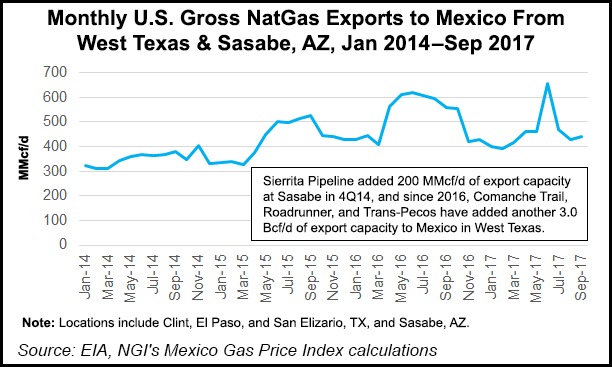NGI Mexico GPI | Infrastructure | NGI All News Access
Mexico Pipelines Facing Delays Like Lower 48, Canada as Native Stakeholders Dissent
At a recent hearing on an indoor soccer court at the foot of Cerro del Brujo, or Shaman’s Hill, in the southern Mexican state of Puebla, a district judge sided with an indigenous community and ordered construction suspended for a key natural gas pipeline underway by TransCanada Corp., further delaying much needed supply.

The 36-inch diameter pipeline, running about 155 miles from South Texas with contracted capacity of 886 MMcf/d, is to terminate in Tula, Hidalgo on the fringes of the huge metropolitan area of Mexico City.
However, the court made the order in response to pleas from the local Otomi indigenous community, which claims that the construction would disturb sacred ground.
The pipeline from Tuxpan on Mexico’s northern Gulf Coast to Tula is one of five pipeline construction projects tendered by the Mexican power utility, Comision Federal de Electricidad that face rights-of-way disputes and social protests.
Mexico’s 2013-2014 energy reform insists on consultations with indigenous groups as part of the permitting processes for construction projects.
Analyst Ramses Pech of the Tabasco-based consultancy Caraiva y Asociados, told NGI that a provision of the energy reform has added to the red tape that is involved in any permitting process.
“What is new in Mexico is the requirement that indigenous communities should be consulted,” he said. “That kind of consultation has long been a part of any project in the U.S. and other countries, but not so here. It was obviously needed in Mexico, too, but it has added to the complexities of the Mexican legal system in areas such as land and rights of way.”
The protests are snarling the flow of Mexico’s imports of U.S. natural gas.
Meanwhile, Tula-Tuxpan represents a $500 million investment by TransCanada. The pipeline would be used to supply gas and allow power plants in central and parts of western Mexico to convert from fuel oil.
TransCanada is by no means the only company that faces delays for its gas pipeline projects. Other delays are being seen by Carso Electric SA de CV, a unit of Grupo Carso, which is controlled by Carlos Slim, Latin America’s most powerful tycoon.
The Carso pipe between Samalayuca in the state of Chihuahua to El Sasabe, Sonora, was due come on stream last month with capacity of up to 550 MMcf/d. In fact, Samalayuca-El Sasabe is not now expected to be ready until about a year’s time.
Carso won the tender to construct and operate the pipeline about two years ago with a $471 million bid. The pipe would supply gas for power plants that currently use fuel oil and would link to another pipeline, from Ojinaga at the U.S. border to El Encino, Chihuahua.
Elsewhere, Infraestructura Energética Nova S.A.B. de CV (IEnova), the Mexican unit of Sempra Energy, won a tender to build the Guaymas-El Oro segment of the 500-mile Sonora pipeline, which runs from the Arizona border south through the Mexican state of Sonora.
The pipeline passes through a region where Jesuit missionaries founded eight missions with neighboring communities of Yaqui natives in the 17th century, which remain to this day. Seven of the Yaqui communities approved Guaymas-El Oro, while only one dissented.
While the dissidents prepared an injunction, temperatures rose sharply. An unidentified group punctured the new pipeline and destroyed some of the equipment that was being prepared to extend it. The state government branded those responsible as “vandals.”*
Mexico City-based Fermaca Services SA de CV is building the Aguascalientes-Villa de Reyes-Guadalajara pipeline, which runs east to west across central Mexico, bestriding the states of Aguascalientes, San Luis Potosi and Jalisco.
The city of Aguascalientes in the same-named state, has boomed as a manufacturing center of Mexico’s export-led auto industry with new vehicle plants in recent years by Nissan, Mazda, General Motors, Honda and Volkswagen.
Guadalajara is Mexico’s second largest city, with almost five million people, where business and labor leaders said gas is urgently needed for new industries to provide more jobs.
The 290-kilometer pipeline was scheduled to be operational early this year, but the latest information is that it won’t come on stream until the first quarter.
Fermaca won the tender for construction and operation of Aguascalientes-Villa de Reyes-Guadalajara with a bid of $270 million. The pipe’s capacity is slated as 885 MMcf/d.
Much more costly liquefied natural gas imports (LNG) are the only viable alternative to pipeline imports. Mexican authorities are poised to announce two tenders this month for long-term LNG contracts to ease the country’s gas shortage.
Mexico has three LNG import terminals: The Altamira LNG facility is on the Gulf Coast, while Manzanillo is sited on the central Pacific, and Energia Costa Azul is near Ensenada in Baja California. Altamira and Manzanillo were running at about 80% of their capacity in late November.
Currently, LNG prices are about $5.00/MMBtu more than imports by pipe.
*Correction: In the original article, NGI misidentified Ojinaga-El Encino as the Sempra Energy pipeline damaged by members of a Yaqui indigenous tribe in northeast Mexico, and incorrectly stated that the project was stalled as a result of the dispute. In fact, it is the Guaymas-El Oro pipeline in Sonora state that was damaged by the tribe, which opposes the project. Moreover, Sempra’s Mexican subsidiary has reported that Guaymas-El Oro and Ojinaga-El Encino both went in service earlier this year. NGI regrets the error.
© 2024 Natural Gas Intelligence. All rights reserved.
ISSN © 2577-9877 | ISSN © 2577-9966 |
